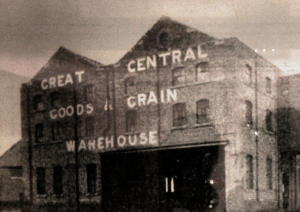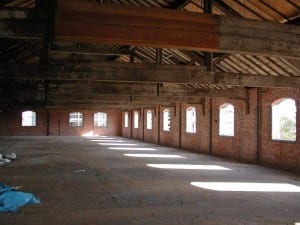Framing Statement
We were set the task of producing a site specific performance within the University of Lincoln Library. As Mike Pearson states, “site specific gives the audience a reason to pause and to stop and appreciate the space we have taken” (2010, 15). Lend a Hand will take place on the 5th May 2016 between the hours of 9am and 9pm which will also include a 5 minute break every hour and each performer is entitled to two half an hour breaks. It is to be situated on the ground floor near the main stairwell and the first floor refuge area. Within our performance, we want to explore the library’s historic past, focusing on its past as a Grains and Goods Warehouse. We strive to keep the key elements of a site specific, post-modern performance, meaning that we are not performing as characters and that our piece has no narrative.
We have chosen to set our performance over the timespan of 12 hours in order to replicate the working hours of the workers from the Grains and Goods Warehouse. We chose to set the heart of our performance in the refuge area as it would reflect upon the cramped, claustrophobic conditions which would have been experienced in the past. An audience is essential for our piece to be successful, as we need audience interaction by them drawing around their hands so that our performance can take place.
When we were in the first initial development stages, as a group we engaged with the “site as symbol, site as story-teller and site as structure”(Wilkie, 2002, 158) as we primarily hope that the audiences who interact and respond to our performance view the library in a different way through telling the story of the library’s history.
Our piece was primarily influenced by the works of performance artist Marina Abramovic, Forced Entertainment’s Nights in this City, Lone Twin’s Totem and Dreamthinkspeak’s One Day, Maybe.
Analysis of Process
As a group, when we first started thinking of ideas for our piece, we wanted to use the whole library as a base to set our performance, in order to open up the audience to areas of the library which they make have not experienced before. Or certainly make them experience known areas in a creative way for them to see the library from a different perspective. One of our original ideas, named Checked Out focused on using the entire library through inviting 3 audience members into a space, blindfolding one of them and allowing the other members to guide the blindfolded member through the library by completing a series of tasks. Ultimately ending in a prize offering upon completion. After receiving guidance from Dr Karen Savage, we were informed that we needed to make our piece more site-specific as we felt our ideas were more site responsive focused. However, we still wanted to use the library as a whole for our performance.
After researching into different theatre companies, we found Forced Entertainment’s Nights in this City (1995). We took inspiration from this project where “a guided tour…(which)…avoided facts in search of a different truth” (Forced Entertainment, 2016) and decided on creating a treasure hunt in the library where we would provide maps and clues for the audience members. The treasure hunt would take the audience on a tour around the library highlighting areas which the audience members may not have been aware of. Expanding from this idea, we wanted our performance to be sensory focused. After exploring the 3rd floor which is the Silent Floor, we wanted to enhance the senses and explore whether the Silent Floor is in fact, ‘silent’. However, once again we felt that this idea was not site specific enough and decided to refer back to the history of the library.
After watching DreamThinkSpeak’s One Day, Maybe (2013) we researched into looking at previous happenings in the library and reliving the conditions that they would have encountered. One Day, Maybe was performed in Gwangju and it was inspired by the student protests which took place during May 1980. Tristan Sharps wanted to take the audience of 2013 and let them imagine what it would have been like for those who died during the protests causing the audience to question the site which they were engaging with.
After researching our site, we discovered that the library was once a Grains and Goods Warehouse and we looked into how we could incorporate grain into our performance. After taking part in practical exploration tasks within the library, our eyes were opened to the possibility of selecting just one area to perform in rather than the whole of the library. Consequently, we decide to focus on using the lifts and the refuge areas located in the library. We initially played with the idea of hosting a ‘welcoming’ tea party which would consist of two group members being sat in the lift with a tea party layout and the other three members of the group being placed in the first floor refuge area with a tea party set up with tables and chairs. Instead of tea, we aimed to pour grain into the tea cups to reference back to the history of the library. Despite this idea being more site specific by incorporating the library’s history, when pitching this idea to Teo and Conan, Conan guided us to focus on grain as a base for our performance. This was one of the key moments within the development process of our performance. Therefore, we made a list of 101 Things to Do with Grain.
We took inspiration from Marina Abramovic’s Counting the Rice (2014). This particular performance consisted of Marina inviting guests to “count individual grains of rice, for six hours, at geometric rice-counting desks” (Rosenthal, 2014) therefore, after buying grain we conducted different experiments based around this inspiration, whilst sat in our chosen performance space, the first floor refuge area. We counted each piece of grain individually, moved pieces of grain from one pile to another, then we decided to make pictures of out the grain. We decided to draw around our hands and stick the grain to the hand drawing. We chose hands to link back to the industrial workplace history and the idea of ‘many hands make light work’ also, we felt that if we made the audience members draw around their own hand, it would make it personal to them. It also teamed the past up with the present by referencing the people who once worked there to the people who visit the library today.
By choosing the refuge area, which is small and would be cramped once a table and chairs were added, and deciding on doing a 12 hour performance to replicate the traditional working hours of the workforce in the Grains and Goods Warehouse, we felt our performance was starting to shape into a site specific performance. With guidance from Teo, who encouraged us to really look into our influences and question whether our ideas are site specific, we researched into more past site specific performances. One which stood out was Lone Twin’s Totem (1998). Totem is a performance where Lone Twin carried a fallen telegraph pole along a straight line drawn through Colchester’s town centre, they “negotiated the streets of Colchester…(and)… The performers costume and activity signalled their place as strangers yet also acted as a catalyst for the public to interact with them” (Govan et al, 2007, 125). Whilst walking through the town centre, any helpers they encountered along the way carved their initials into the pole. We took this as inspiration for our piece and came up with the idea of the volunteers signing their initials or name onto the sheet of paper once they’ve completed drawing around their hand. In addition, “the physically gruelling effort expanded by the performers drew attention to the actual process of labour inherent in the piece” (Govan et al, 2007) this links to our performance being based on the hard work labour conducted by the past workers and the labour process we were to encounter when performing.
After finalising our proposed idea for the performance we began experimenting and developing the piece. We decided that the completed grain hands were to be displayed on the wall finishing as an installation piece. Similar to Forced Entertainment’s Nights in this City (1995) where their performance concluded with “an installation in which the entire street index for the city was written out in chalk on the floor of a found space” (Forced Entertainment, 2016) with our ‘found space’ to be the wall which audience members pass as they walked to our performance. We initially wanted to time how long it would take to create a hand out of grain, this came to a total of 1 hour 7 minutes after drawing around our own hands.
Whilst developing our idea we decided to incorporate multimedia into our performance. By including multimedia, it allowed us to bring the 21st century into our performance. Initially we thought about the idea of creating a visual and audio video which spoke of facts about the library, however we felt that this would be too much of a distraction of our main performance. Therefore, we thought back to our idea of recreating the working conditions and created a sound scape of a working factory which would be played in the background of our performance. In addition, due to the decision of wanting all of our group members to be at the table where the grain hands were being produced, we created an instruction video which guided the volunteers to draw around their hands which was to be played via a laptop situated on the ground floor next to the staircase which lead to the refuge area.
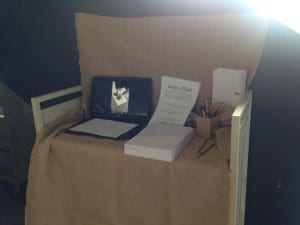
In addition to the multimedia, we created maps which were used to guide the audience members from the entrance of the library, which was where our performance began, to the refuge area. The map was hand draw with pencil to represent the past and how technology was not used in the times of the Grains and Goods Warehouse, the same way it is now. We also felt that with the map being hand drawn in pencil, it made it more personal and links to when the audience mark their initials on their hands. Myself and a couple of the group members met up and created a paper mache hand sculpture which was covered in grain and was placed at the start of the performance with the maps.
We then composed a list of what we would like to achieve from our performance. After experimenting with the timings it takes to complete each hand, we set the aim of completing a minimum of 30 hands within the allotted time in order to create a noticeable installation. We wanted the audience to view the library from a different perspective and we strived to educate them of the library’s past. We also wanted to focus on the comparison of workforces of the past and present, we aimed to do this by highlighting that workers no longer make a whole product alone anymore, it is now a norm for different people to only make sections of a product.
https://www.youtube.com/watch?v=am9Z3b7m3iI
Performance Evaluation
Our performance began as the audience members walked into the library, at the barriers there was the grain hand sculpture which was accompanied by the maps and a sign which stated that if people wished to take part in the performance, they may take a map. We had arrows made of grain placed along the path stated on the map which lead up to the refuge area. The audience members were led to the positioned laptop where they followed the instructions which were left out for them. Up in the refuge area, the area was dressed with hessian. We chose to dress the area with hessian as this was the material which was used for the sacks which held the grain. We also covered the table with old pictures of the library which showed it as a Goods and Grains Warehouse, which would inform the audience more about its history. As a group we placed individual grains one by one onto each hand with PVA glue. We each had a hand to individually create. Once each hand was completed it was placed on an overspill trolley for approximately 30 minutes whilst the glue dried. Once dry, the hands were placed on the wall to create the final installation piece. The final installation was on display over night after the performance had ended.
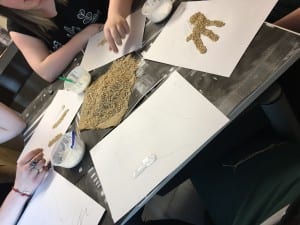
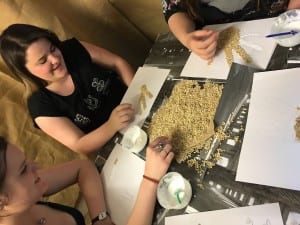
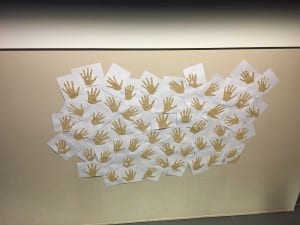
Personally, I feel that we had a strong performance, we received greater reception that expected as we exceeded our predicted 30 completed hands with a grand total of 54 hands after the 12 hour shift. We encountered unexpected audience participation, as one audience member joined the group for over an hour and created her own grain hand. With this participation we were able to develop our performance by adding a chair to the table, providing the option for people to join us. I experienced manual labour of one particular product for a duration of 12 hours and performed in a confined, dressed area representative of the space’s history. We took audience’s reactions into consideration throughout the durational piece and constantly developed our piece based on these reactions.
One of the main weaknesses which we encountered was that we ran out of materials during our performance, however we had back up planned so that more materials could be gathered to continue the performance. Despite planning minor details in advance there was a lack of preparation and we left some tasks until the last minute, such as printing out the pictures which were to be displayed around the space. There was a lack of teamwork in some aspects of the performance, and a lack of clarity in the instructions we left as some audience members brought their pieces of card to us rather than leaving them near the laptop.
If I was to take part in this durational performance again I would pay more attention to detail and plan the finer details in advance. I would also make the instructions which were left near the laptop clearer. I would also explore the possibilities of using different tools in order to speed up the process of making the grain hands, for example tools where numerous grains would be placed at a time rather than individually. What worked particularly well with the performance is that with it being 12 hours long I was able to train myself into a rhythm when creating the hands. The rhythm meant that I was completing hands quicker and overall the rhythm of collecting card, creating the hands and placing them on the wall became a faster more effective process as time went on.
By engaging with site-specific theory and practices, it has enable me to view specific sites in different perspectives and knowing that you do not need to create a character or develop a script in order to put on a successful performance. It has also been made clear to me that there is a lot of development and successful practices you can undertake within a confined space rather than a traditional stage. I have learnt that when you are creating a site-specific performance, it is key to respond to the site in order to create something specific. This module has opened my mind to not judge places on first impressions and to take the opportunity to see places in a different light. After the performance of our durational piece, I have gained a different perspective on our specific performance area and on the library as a whole and I hope that through our performance other members of the library see the library in a different way and have learnt about the history of what it used to be.
Word count – 2647
Works Cited
Abramovic, M. (2014) Counting the Rice. [Performance Art] Geneva, Switzerland.
Bowe, K. (2016) Lincoln. Print.
Dreamthinkspeak (2013) One Day, Maybe by Dreamthinkspeak. [online video] Available from https://www.youtube.com/watch?v=yLUeQ90hu-Q [Accessed 4 May 2016]
Forced Entertainment (1995) Nights in this City. [Performance Art] Sheffield, UK.
Forced Entertainment (2016) Nights in this City. [online] Forced Entertainment. Available from http://www.forcedentertainment.com/project/nights-in-this-city/ [Accessed 3 May 2016].
Govan, E., Nicholson, H. and Normington, K (2007) Making a Performance: Devising Histories and Contemporary Practices. London and New York: Routledge.
Lone Twin (1998) Totem. [Performance Art] Colchester, UK.
Pearson, M. (2010) Site-specific performance. Basingstoke: Palgrave Macmillan.
Rosenthal, E (2014) It’s Art: Marina Abramovic Counts Grains of Rice. [online] Available from http://thecreatorsproject.vice.com/en_uk/blog/marina-abramovic-counts-grains-of-rice [Accessed 28 April 2016].
Wilkie, F. (2002) Mapping the Terrain: A Survey of Site-Specific Performance in Britain. New Theatre Quarterly. 18 (2) 140 – 161.
